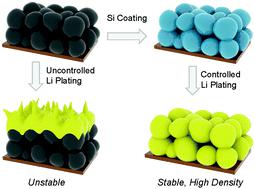当前位置:
X-MOL 学术
›
Energy Environ. Sci.
›
论文详情
Our official English website, www.x-mol.net, welcomes your
feedback! (Note: you will need to create a separate account there.)
High energy density anodes using hybrid Li intercalation and plating mechanisms on natural graphite
Energy & Environmental Science ( IF 32.4 ) Pub Date : 2020-09-17 , DOI: 10.1039/d0ee02230f Yeonguk Son 1, 2, 3, 4 , Taeyong Lee 5, 6, 7, 8, 9 , Bo Wen 1, 2, 3, 4, 10 , Jiyoung Ma 5, 6, 7, 8, 9 , Changshin Jo 1, 2, 3, 4, 11 , Yoon-Gyo Cho 12, 13, 14, 15 , Adam Boies 1, 2, 3, 4 , Jaephil Cho 5, 6, 7, 8, 9 , Michael De Volder 1, 2, 3, 4
Energy & Environmental Science ( IF 32.4 ) Pub Date : 2020-09-17 , DOI: 10.1039/d0ee02230f Yeonguk Son 1, 2, 3, 4 , Taeyong Lee 5, 6, 7, 8, 9 , Bo Wen 1, 2, 3, 4, 10 , Jiyoung Ma 5, 6, 7, 8, 9 , Changshin Jo 1, 2, 3, 4, 11 , Yoon-Gyo Cho 12, 13, 14, 15 , Adam Boies 1, 2, 3, 4 , Jaephil Cho 5, 6, 7, 8, 9 , Michael De Volder 1, 2, 3, 4
Affiliation

|
Lithium plating on conventional graphite anodes in lithium-ion batteries is typically considered an undesirable side reaction, a safety hazard or a degradation mechanism. However, lithium plating and stripping allow for efficient energy storage, and therefore various new porous anode designs with tailored surface coatings and electrolyte systems have been proposed to achieve reversible Li plating and stripping. Unfortunately, these material designs often rely on highly porous plating scaffolds with an overall lower volumetric energy and power density than conventional graphite anodes. Herein, a novel anode design is presented which leverages the good volumetric performance of industrial graphite anodes and further enhances their capacity by allowing for a reversible Li plating on their surface. The latter is achieve by conformally coating them with a nanoscale lithiophilic Si coating. As a result, excellent volumetric energy densities of 656 mA h cm−3 and gravimetric capacities of 551 mA h g−1 are achieved, which are a clear improvement compared to the commercial graphite anode (app. 570 mA h cm−3 and 360 mA h g−1 respectively). Moreover, by carefully balancing the thickness of the Si layer and the plating capacity, a capacity retention close to 100% is achieved after 200 cycles in half cells. Overall, this approach leverages the advances in industrial graphite anode manufacturing while at the same time embracing the additional capacity offered by reversible plating and stripping of Li metal, resulting in full cells energy densities of 474 W h kg−1 and 912 W h L−1, which is a step forward compared to previous Li metal and graphite anodes.
中文翻译:

在天然石墨上使用混合锂嵌入和电镀机制的高能量密度阳极
锂离子电池中常规石墨阳极上的锂电镀通常被认为是不良的副反应,安全隐患或降解机理。然而,锂电镀和剥离允许有效的能量存储,因此已经提出了各种具有定制表面涂层和电解质体系的新型多孔阳极设计,以实现可逆的锂电镀和剥离。不幸的是,这些材料设计经常依赖于高度多孔的电镀支架,该支架总体上具有比常规石墨阳极更低的体积能量和功率密度。本文中,提出了一种新颖的阳极设计,该设计利用了工业石墨阳极的良好体积性能,并通过允许在其表面上进行可逆的Li镀层来进一步提高了其容量。后者是通过用纳米级亲硫性Si涂层保形地涂覆它们来实现的。结果,极好的656 mA h cm的体积能量密度达到了3-5 mA hg -1的-3和重量,与商用石墨阳极(分别为570 mA h cm -3和360 mA hg -1)相比有明显的提高。而且,通过仔细地平衡Si层的厚度和电镀容量,在半电池中经过200次循环后,容量保持率接近100%。总之,该方法利用在工业石墨阳极制造的进步,而在同一时间通过拥抱可逆电镀和汽提Li金属的,从而导致的474 W时千克全电池的能量密度所提供的额外容量-1和912 w ^ H L -如图1所示,与以前的Li金属和石墨阳极相比,这是一个进步。
更新日期:2020-10-14
中文翻译:

在天然石墨上使用混合锂嵌入和电镀机制的高能量密度阳极
锂离子电池中常规石墨阳极上的锂电镀通常被认为是不良的副反应,安全隐患或降解机理。然而,锂电镀和剥离允许有效的能量存储,因此已经提出了各种具有定制表面涂层和电解质体系的新型多孔阳极设计,以实现可逆的锂电镀和剥离。不幸的是,这些材料设计经常依赖于高度多孔的电镀支架,该支架总体上具有比常规石墨阳极更低的体积能量和功率密度。本文中,提出了一种新颖的阳极设计,该设计利用了工业石墨阳极的良好体积性能,并通过允许在其表面上进行可逆的Li镀层来进一步提高了其容量。后者是通过用纳米级亲硫性Si涂层保形地涂覆它们来实现的。结果,极好的656 mA h cm的体积能量密度达到了3-5 mA hg -1的-3和重量,与商用石墨阳极(分别为570 mA h cm -3和360 mA hg -1)相比有明显的提高。而且,通过仔细地平衡Si层的厚度和电镀容量,在半电池中经过200次循环后,容量保持率接近100%。总之,该方法利用在工业石墨阳极制造的进步,而在同一时间通过拥抱可逆电镀和汽提Li金属的,从而导致的474 W时千克全电池的能量密度所提供的额外容量-1和912 w ^ H L -如图1所示,与以前的Li金属和石墨阳极相比,这是一个进步。











































 京公网安备 11010802027423号
京公网安备 11010802027423号